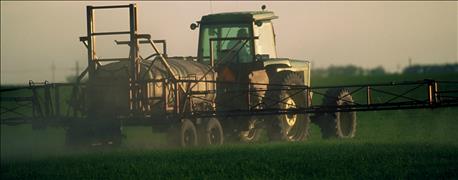April 24, 2016

Richard Zollinger, North Dakota State University Extension weed specialist, and Kirk Watt, NDSU weed scientist, answer questions about leafy spurge spray damage and spraying after frost damage.

Herbicide is applied to a field of small grains.
Leafy spurge spray damage
Question:Last year a producer applied Milestone at 5 fluid ounces per acre, plus Plateau at 7 fluid ounces per acre to his pasture to control leafy spurge, Canada thistle and buckbrush. This year the pasture grass was killed and weed control was good except for buckbrush. He wanted to reseed his grass now. The weed officer and I can’t figure out what killed his grass since the grower used labeled herbicide rates. Is it safe to reseed? Also, the weed board was wondering why they have many spots on the right of way that last fall look good with good spurge control but this spring it caused the grass to be brown and just now it is starting to green up and grow. What caused the grass to turn brown?
Answer: Cool season grass species injury to Plateau in not unusual. I have seen it the year after treatment, even at application rates as low as 6 fl oz/A. The grass usually comes back slowly and by the end of July or early August, the pasture looks normal again. I would tell the producer to hold off on reseeding as it may not be necessary because the grass is likely suppressed and not dead. Neither Plateau nor Milestone is effective on buckbrush. 2,4-D works well and is the least expensive option for buckbrush control.
The cool season grass species were probably under stress last fall from dry conditions which likely magnified the injury response you have seen. I have seen more injury in fields treated with Plateau following a dry compared to wet fall. I have not seen grass injury from Plateau at 4 fl oz/A applied with Tordon and 2,4-D in June, a treatment used by many and dubbed the “North Dakota 3-way”. Another option for areas that are not hayed or grazed is Perspective applied in the spring or fall. Some people use Tordon plus Overdrive in the spring and many still use the old standby Tordon plus 2,4-D.
Spraying after frost injury
Question: How soon can I make my herbicide application to my wheat and barley that have been injured by frost?
Answer: The short answer: After three or so days of growth and evidence of new green plant tissue produced. Plants require time to recover from the frost and resume normal metabolism necessary to breakdown applied pesticides. Small grain plants that only show minor frost injury, such as desiccated leaf tips, may only need a day to resume normal growth if day-time temperatures initiate growth after the frost. Those plants that show significant injury will require evidence of new growth before herbicide applications can be made. To determine viability of wheat and barley plants, cut the main stem with a knife and observe the growing point. If the growing point is white then the area is unaffected. A tan or brown tissue means the growing point has been injured and plants may not recover. Low areas of the field will likely be affected the most rather than the entire field. Weeds may not show much frost damage, but in cases where weed tissue is injured, herbicide efficacy may be reduced. Grass weeds beginning to tiller and broadleaf weeds that are 3 to 4 inches tall may require timely herbicide application to prevent yield loss from weed competition regardless of frost injury. Group 1 grass herbicides used in small grains contain a safener which increases crop safety to the herbicide. For wheat, many Group 2 herbicides also include a safener, but the level of safety has not been as high as with Group 1 herbicides. The risk of injury and yield loss with Group 2 grass herbicides increases substantially after the 5-leaf stage. When staging small grains remember to include leaves destroyed by frost. Group 2 broadleaf herbicides require active metabolism in wheat and barley plants for adequate crop safety and these herbicides can increase injury with Group 2 grass herbicides when applied together.
You May Also Like




